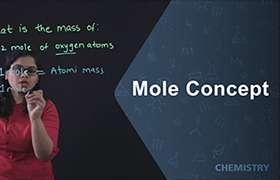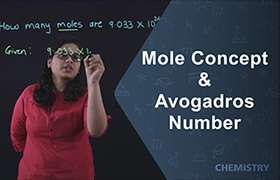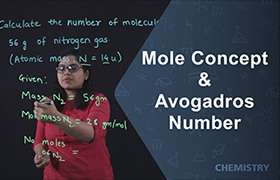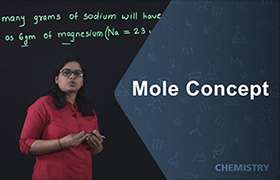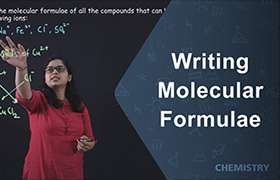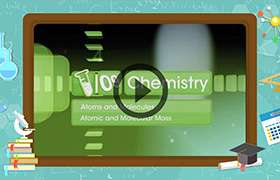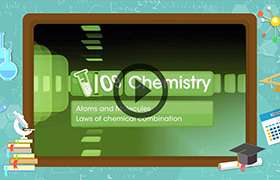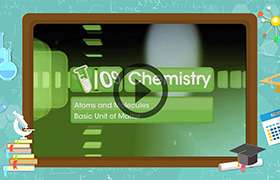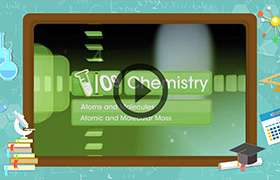CBSE Class 9 Answered
Can you teach Formation of compounds with iagrams and all?
Asked by | 30 May, 2008, 08:04: PM
Though the periodic table has only 118 or so elements, there are obviously more substances in nature than 118 pure elements. This is because atoms can react with one another to form new substances called compounds. Formed when two or more atoms chemically bond together, the resulting compound is unique both chemically and physically from its parent atoms.In ionic bonding, electrons are completely transferred from one atom to another. In the process of either losing or gaining negatively charged electrons, the reacting atoms form ions. The oppositely charged ions are attracted to each other by electrostatic forces, which are the basis of the ionic bond.
For example, during the reaction of sodium with chlorine: sodium loses its one valence electron to chlorine resulting in a positively charged sodium ion and a negatively charged chlorine ionwhen sodium loses its one valence electron it gets smaller in size, while chlorine grows larger when it gains an additional valence electron. This is typical of the relative sizes of ions to atoms. Positive ions tend to be smaller than their parent atoms while negative ions tend to be larger than their parent. After the reaction takes place, the charged Na+ and Cl- ions are held together by electrostatic forces, thus forming an ionic bond. Ionic compounds share many features in common:
Ionic bonds form between metals and nonmetals.
In naming simple ionic compounds, the metal is always first, the nonmetal second (e.g., sodium chloride).
Ionic compounds dissolve easily in water and other polar solvents.
In solution, ionic compounds easily conduct electricity.
Ionic compounds tend to form crystalline solids with high melting temperatures
The second major type of atomic bonding occurs when atoms share electrons. As opposed to ionic bonding in which a complete transfer of electrons occurs, covalent bonding occurs when two (or more) elements share electrons. Covalent bonding occurs because the atoms in the compound have a similar tendency for electrons (generally to gain electrons). This most commonly occurs when two nonmetals bond together. Because both of the nonmetals will want to gain electrons, the elements involved will share electrons in an effort to fill their valence shells. A good example of a covalent bond is that which occurs between two hydrogen atoms. Atoms of hydrogen (H) have one valence electron in their first electron shell. Since the capacity of this shell is two electrons, each hydrogen atom will "want" to pick up a second electron. In an effort to pick up a second electron, hydrogen atoms will react with nearby hydrogen (H) atoms to form the compound H2. Because the hydrogen compound is a combination of equally matched atoms, the atoms will share each other's single electron, forming one covalent bond. In this way, both atoms share the stability of a full valence shell.
Unlike ionic compounds, covalent molecules exist as true molecules. Because electrons are shared in covalent molecules, no full ionic charges are formed. Thus covalent molecules are not strongly attracted to one another. As a result, covalent molecules move about freely and tend to exist as liquids or gases at room temperature.
Multiple Bonds: For every pair of electrons shared between two atoms, a single covalent bond is formed. Some atoms can share multiple pairs of electrons, forming multiple covalent bonds. For example, oxygen (which has six valence electrons) needs two electrons to complete its valence shell. When two oxygen atoms form the compound O2, they share two pairs of electrons, forming two covalent bonds.
Lewis Dot Structures: Lewis dot structures are a shorthand to represent the valence electrons of an atom. The structures are written as the element symbol surrounded by dots that represent the valence electrons.
There are, in fact, two subtypes of covalent bonds. The H2 molecule is a good example of the first type of covalent bond, the nonpolar bond. Because both atoms in the H2 molecule have an equal attraction (or affinity) for electrons, the bonding electrons are equally shared by the two atoms, and a nonpolar covalent bond is formed. Whenever two atoms of the same element bond together, a nonpolar bond is formed.
A polar bond is formed when electrons are unequally shared between two atoms. Polar covalent bonding occurs because one atom has a stronger affinity for electrons than the other (yet not enough to pull the electrons away completely and form an ion). In a polar covalent bond, the bonding electrons will spend a greater amount of time around the atom that has the stronger affinity for electrons. A good example of a polar covalent bond is the hydrogen-oxygen bond in the water molecule
Water molecules contain two hydrogen atoms bonded to one oxygen atom . Oxygen, with six valence electrons, needs two additional electrons to complete its valence shell. Each hydrogen contains one electron. Thus oxygen shares the electrons from two hydrogen atoms to complete its own valence shell, and in return shares two of its own electrons with each hydrogen, completing the H valence shellsThe primary difference between the H-O bond in water and the H-H bond is the degree of electron sharing. The large oxygen atom has a stronger affinity for electrons than the small hydrogen atoms. Because oxygen has a stronger pull on the bonding electrons, it preoccupies their time, and this leads to unequal sharing and the formation of a polar covalent bond.
The Dipole
Because the valence electrons in the water molecule spend more time around the oxygen atom than the hydrogen atoms, the oxygen end of the molecule develops a partial negative charge (because of the negative charge on the electrons). For the same reason, the hydrogen end of the molecule develops a partial positive charge. Ions are not formed; however, the molecule develops a partial electrical charge across it called a dipole. The water dipole is represented by the arrow in which the head of the arrow points toward the electron dense (negative) end of the dipole and the cross resides near the electron poor (positive) end of the molecule.
For example, during the reaction of sodium with chlorine: sodium loses its one valence electron to chlorine resulting in a positively charged sodium ion and a negatively charged chlorine ionwhen sodium loses its one valence electron it gets smaller in size, while chlorine grows larger when it gains an additional valence electron. This is typical of the relative sizes of ions to atoms. Positive ions tend to be smaller than their parent atoms while negative ions tend to be larger than their parent. After the reaction takes place, the charged Na+ and Cl- ions are held together by electrostatic forces, thus forming an ionic bond. Ionic compounds share many features in common:
Ionic bonds form between metals and nonmetals.
In naming simple ionic compounds, the metal is always first, the nonmetal second (e.g., sodium chloride).
Ionic compounds dissolve easily in water and other polar solvents.
In solution, ionic compounds easily conduct electricity.
Ionic compounds tend to form crystalline solids with high melting temperatures
The second major type of atomic bonding occurs when atoms share electrons. As opposed to ionic bonding in which a complete transfer of electrons occurs, covalent bonding occurs when two (or more) elements share electrons. Covalent bonding occurs because the atoms in the compound have a similar tendency for electrons (generally to gain electrons). This most commonly occurs when two nonmetals bond together. Because both of the nonmetals will want to gain electrons, the elements involved will share electrons in an effort to fill their valence shells. A good example of a covalent bond is that which occurs between two hydrogen atoms. Atoms of hydrogen (H) have one valence electron in their first electron shell. Since the capacity of this shell is two electrons, each hydrogen atom will "want" to pick up a second electron. In an effort to pick up a second electron, hydrogen atoms will react with nearby hydrogen (H) atoms to form the compound H2. Because the hydrogen compound is a combination of equally matched atoms, the atoms will share each other's single electron, forming one covalent bond. In this way, both atoms share the stability of a full valence shell.
Unlike ionic compounds, covalent molecules exist as true molecules. Because electrons are shared in covalent molecules, no full ionic charges are formed. Thus covalent molecules are not strongly attracted to one another. As a result, covalent molecules move about freely and tend to exist as liquids or gases at room temperature.
Multiple Bonds: For every pair of electrons shared between two atoms, a single covalent bond is formed. Some atoms can share multiple pairs of electrons, forming multiple covalent bonds. For example, oxygen (which has six valence electrons) needs two electrons to complete its valence shell. When two oxygen atoms form the compound O2, they share two pairs of electrons, forming two covalent bonds.
Lewis Dot Structures: Lewis dot structures are a shorthand to represent the valence electrons of an atom. The structures are written as the element symbol surrounded by dots that represent the valence electrons.
There are, in fact, two subtypes of covalent bonds. The H2 molecule is a good example of the first type of covalent bond, the nonpolar bond. Because both atoms in the H2 molecule have an equal attraction (or affinity) for electrons, the bonding electrons are equally shared by the two atoms, and a nonpolar covalent bond is formed. Whenever two atoms of the same element bond together, a nonpolar bond is formed.
A polar bond is formed when electrons are unequally shared between two atoms. Polar covalent bonding occurs because one atom has a stronger affinity for electrons than the other (yet not enough to pull the electrons away completely and form an ion). In a polar covalent bond, the bonding electrons will spend a greater amount of time around the atom that has the stronger affinity for electrons. A good example of a polar covalent bond is the hydrogen-oxygen bond in the water molecule
Water molecules contain two hydrogen atoms bonded to one oxygen atom . Oxygen, with six valence electrons, needs two additional electrons to complete its valence shell. Each hydrogen contains one electron. Thus oxygen shares the electrons from two hydrogen atoms to complete its own valence shell, and in return shares two of its own electrons with each hydrogen, completing the H valence shellsThe primary difference between the H-O bond in water and the H-H bond is the degree of electron sharing. The large oxygen atom has a stronger affinity for electrons than the small hydrogen atoms. Because oxygen has a stronger pull on the bonding electrons, it preoccupies their time, and this leads to unequal sharing and the formation of a polar covalent bond.
The Dipole
Because the valence electrons in the water molecule spend more time around the oxygen atom than the hydrogen atoms, the oxygen end of the molecule develops a partial negative charge (because of the negative charge on the electrons). For the same reason, the hydrogen end of the molecule develops a partial positive charge. Ions are not formed; however, the molecule develops a partial electrical charge across it called a dipole. The water dipole is represented by the arrow in which the head of the arrow points toward the electron dense (negative) end of the dipole and the cross resides near the electron poor (positive) end of the molecule.
Answered by | 31 May, 2008, 12:00: AM
Application Videos
Concept Videos
CBSE 9 - Chemistry
Asked by rajputanaji290 | 03 Oct, 2023, 09:30: PM
CBSE 9 - Chemistry
Asked by muditsharma287 | 09 Mar, 2023, 10:10: PM
CBSE 9 - Chemistry
Asked by shivalaxmi0205 | 08 Mar, 2023, 07:46: PM
CBSE 9 - Chemistry
Asked by shivalaxmi0205 | 08 Mar, 2023, 07:43: PM
CBSE 9 - Chemistry
Asked by jssjj | 19 Jan, 2023, 07:25: PM
CBSE 9 - Chemistry
Asked by mohammedhaqqani.6b | 14 Jun, 2022, 02:51: PM
CBSE 9 - Chemistry
Asked by gauravsingh36428 | 14 Mar, 2022, 07:44: PM
CBSE 9 - Chemistry
Asked by jiyajthakor | 28 Feb, 2022, 07:03: PM
CBSE 9 - Chemistry
Asked by gillsaabjashanpreetsingh3 | 16 Jan, 2022, 01:23: PM
CBSE 9 - Chemistry
Asked by prachisharma772007 | 16 Jan, 2022, 11:12: AM

